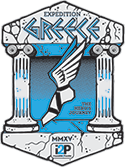Classroom Activities For Teachers by Teachers
Topic Focus
Learning how to think about money and manage it wisely is one of the most valuable life skills that can be learned early in age. Limited understanding of money management promotes habits that may lead to costly financial mistakes today and in the future. Developing a basic understanding of our spending habits, how banks work, how proper investments can benefit an individual as well as how to avoid debt or any extra fees charged to you is crucial. Being equipped with a good understanding of choices, consequences and personal responsibility for actions will better prepare youth for a sound financial future. Building this foundation of managing money well can help determine the quality of your future life.
Join the i2P Team as they probe into these areas of money management while running through the historical sites of beautiful Greece.
Generations Interview
Should teens have credit cards?
Funding the Olympic Dream
Introduction:
Achieving the Olympic dream requires more than just athletic skill – it also requires good financial planning. You might be surprised to learn that being an Olympic athlete is rarely a get rich quick plan. Training and competition costs are significant, from purchasing equipment to travel expenses to coaching fees. Yet, unless you’re a champion in a popular sport, it’s hard to get the lucrative sponsorship deals that many of us associate with performance athletics. So how do athletes pay their way? Olympians rely on a variety of funding sources and their own resiliency to support their Olympic dreams.
Objectives:
- Help students recognize the importance of financial planning to support career and personal endeavors
- Help students learn about different sources of funding
- Help students identify what characteristics make Olympic athletes financially successful
- Help students develop critical thinking and summarizing skills
Activity 1:
- Provide students with an overview of Olympic funding needs (see introduction)
- Give students a copy of the following newspaper article and have them read it individually or in teams:
Olympic dream can be costly for athletes - While reading, ask students to write down and summarize all the examples of athlete funding sources mentioned in this article Regroup as a class to make a complete list of funding sources
Discussion:
- Were students surprised by the financial hardship many athletes face?
- What are the benefits and drawbacks of each funding method?
- Who has the most difficulty securing funding?
-
What personal characteristics must Olympians exhibit to reach their funding needs and athletic dreams?
- Ex: Goal-setting, bouncing back from adversity, seeking out coaching/mentorship, focused mindset, ability to celebrate success
Activity 2:
- Ask students to research their favorite Olympic hero in groups to find out how these athletes fund their Olympic dreams
- Have each group present their research to the class and compare the results
Discussion:
- What personal goals do students have and what are they doing to meet them?
Resources:
- Olympic dream can be costly for athletes - Boston Globe
- The toughest race for Olympic athletes is the one for funding - CNBC
- 5 Business Lessons from Olympic Athletes - Pinnacle Financial Partners
- 7 Olympic Training Lessons for Your Finances - Forbes
The Danger of Debt and Minimum Payments
Introduction:
Once approved for a credit card, it becomes extremely easy to spend money that you don’t have. Provided that you make the minimum payment each month, your credit rating remains in good standing. It would seem then that all is well; however, this couldn’t be further from the truth. Though making the minimum payment each month does not affect your credit rating, it does affect the length of time that it will take to pay off your balance (money that you owe), not to mention how much it will actually cost you once you have paid off your debt. This is purely because of the interest rates applied to your remaining balance when you do not pay it off in full. Though minimum payments do reduce the total balance, the reduction is minimal compared to the amount of interest that is being applied.
For this reason, the total amount that you end up paying is far greater than what you owed in the first place. Many people are unaware that credit cards work in this way and the consequences for this are extremely costly.
Definitions:
Note: All definitions taken directly from investopedia.com
- Interest: “The charge for the privilege of borrowing money, typically expressed as an annual percentage rate.”
- Minimum Monthly Payment: “The smallest amount of a credit card bill that a consumer can pay, to remain in good standing with the credit card company. Making the monthly minimum payment on time is the least a consumer needs to do, to avoid late fees and to have a good repayment history on his credit report. The amount of the minimum monthly payment is calculated as a small percentage of the consumer's total credit balance.”
Objectives:
- Help students understand a minimum payment
- Help students recognize how making only minimum payments contributes to furthering debt
- Help students realize the consequences of paying interest on a loan
Activity: The Price is Right... or Wrong
- Provide students an overview of the lesson, as well as some background information pertaining to credit cards, minimum payments and debt (refer to Introduction above)
- Divide class into teams of 4-5
- Read aloud one of the financial scenarios (see below)
-
Once students have heard the scenario, each team must try to guess two thing:
- how long it would take the individual to pay off his/her debt
- how much they would end up paying in total
- Record each team’s guess for both “categories” (length of time and total $)
- Reveal the correct answer - the team who was closest (without going over) earns a point (scoring system to be determined by teacher)
- Repeat steps 3-6 for each of the remaining financial scenarios
Financial Scenarios
- You finally were able to book the necessary time off work to go on that dream vacation you have always talked about. In order to pay for the cost of plane tickets, accommodations in a decent hotel, meals, souvenirs and other expenses for tourist activities, you end up charging $5,000 to your credit card, which has an interest rate of 18.9%. You decide that you can only afford to pay off the minimum payment of $200 each month. How long will it take you to pay off your vacation? How much will it end up costing you once it is all paid off?
- You’re tired of having to squint at the small TV across the room. You decide to invest in a plasma TV, which will make your house the location of choice for all your friends’ movie marathons. The cost of the TV is $1,000, so you put it on your credit card, which has an interest of 18%. However, you can only afford the minimum payment of $10 or 2% per month (whichever is greater). How long will it take you to pay off your plasma TV? How much will it end up costing you once it is all paid off?
- You haven’t been able to pick up as many shifts at your job, but you still need to buy groceries, pay some medical bills and pay for heat and electricity. Over the course of the month, you charge $1,437.47 to your credit card. It offers great rewards, but the interest rate is 19.97%. Unfortunately, money is tight, so you are only able to make the minimum payments: $10 or 2% of the balance - whichever is greater. How long will you have to continue making minimum payments until the balance is paid off? How much will you end up paying in the long run?
- In an effort to earn better customer rewards, you sign up for a department store credit card, with an interest rate of 29.9%. To celebrate the arrival of your new card, you go on a bit of an online shopping spree, spending a grand total of $500. You don’t feel like paying more than the minimum payment, because spending less on credit card payments means that you free up more cash to spend on something else! As a result, you pay only $10 or 2.2% of the balance every month (whichever is greater).
- You decide to register for driving lessons. After much research, you settle on a company that offers 6 lessons for $250. You don’t have the cash up front, so you elect to pay for it using your credit card (interest rate of 19.99%). You can’t understand why anyone would choose to pay off the balance in full when they could simply pay a small amount of money each month. You believe that this will be a more manageable way of paying for the lessons.
Discuss:
- How did students find the experience?
- What did they learn about credit card debt?
- What might be some of the benefits and consequences of making minimum payments?
- What are some of the advantages and disadvantages of accumulating debt?
- How might debt affect other areas of an individual’s life (aside from the financial impact)?
- What strategies might help individuals avoid getting caught in this “debt trap”?
- Does this information affect their attitude towards credit cards, or make them want to change their financial habits in the present/future?
Resources:
Explore Additional Financial Literacy Classroom Activities Here
California: http://impossible2possible.com/lost-coast/financial-literacy/activities
Atacama: http://impossible2possible.com/atacama2014/financial-literacy/activities
Peru: http://impossible2possible.com/peru/financial-literacy/activities
Utah: http://impossible2possible.com/utah/extraordinary
Botswana: http://impossible2possible.com/botswana/extraordinary#tri-center






